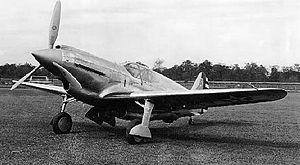Curtiss XP-46 Video - Picture

|
|
Curtiss XP-46
XP-46

Picture - Curtiss XP-46 (USAF photo)
Role: Fighter
Manufacturer: Curtiss-Wright Corporation
Designed by: Donovan Berlin
First flight: 15 February 1941
Primary user: United States Army Air Corps (intended)
Number built: 2
Developed from: Curtiss P-40
Developed into: Curtiss XP-53
The Curtiss XP-46 was a 1940s United States prototype fighter aircraft. It was a development of the Curtiss-Wright Corporation in an effort to introduce the best features found in European fighter aircraft in 1939 into a fighter aircraft which could succeed the Curtiss P-40, then in production.
Design and development
A United States Army Air Corps (USAAC) specification based upon a Curtiss proposal was the basis for an order placed in September 1939 for the XP-46. The requirements called for a single-engine, low-wing aircraft, slightly smaller than the P-40, and with a wide-track, inward-retracting landing gear. The selected powerplant was an 1,150 hp (858 kW) Allison V-1710-39 V-12 engine. The planned armament included two .50 in (12.7 mm) synchronized machine guns in the forward fuselage and provisions for eight .30 in (7.62 mm) wing-mounted guns. The USAAC later added requirements for self-sealing fuel tanks and 65 lb (29 kg) of armor, the weights of which were to adversely affect performance.
Testing
Two prototype aircraft were delivered, designated XP-46A, with first flight occurring on 15 February 1941. However, the USAAC decided in July 1940 (while the XP-46s were under construction) to replace the XP-46 procurement effort with an upgraded P-40 which would use the planned XP-46 engine. In this manner, a serious disruption of the Curtiss production line would be avoided.
Subsequently, the performance during trials of the XP-46 was found inferior to the upgraded P-40 (designated P-40D).
A myth surrounding the origins of the P-51 Mustang is linked to the North American Aviation (NAA) purchase of test data on the P-40 and P-46. NAA paid $56,000 to Curtiss for technical aerodynamic data on the XP-46 and although there are certain design similarities in the radiator/oil-cooler configuration, the new NA-73X (the company designation for the future P-51) even in preliminary design had already progressed beyond the XP-46 . In addition, after the war, NAA engineers revealed that they had learned of a European study (before the US entry into World War II) which indicated the value of a well-designed embedded radiator, and were eager to apply that knowledge to a new design.
Specifications (Curtiss XP-46A)
Data from Curtiss Aircraft 1907-1947
General characteristics
Crew: one
Length: 30 ft 2 in (9.19 m)
Wingspan: 34 ft 3¾ in (10.45 m)
Height: 10 ft 1 in (3.07 m)
Wing area: 208 ft² (19.32 m²)
Empty weight: 5,625 lb (2,551 kg)
Max takeoff weight: 7,665 lb (3,477 kg)
Powerplant: 1x— Allison V-1710-39 liquid-cooled V12 engine, 1,150 hp (858 kW)
Performance
Maximum speed: 355 mph (309 knots, 571 km/h) at 12,200 ft (3,720 m)
Range: 325 mi (283 nmi, 523 km)
Climb to 12,300 ft (3,750 m): 5 min
Armament
Guns:
2 x— .50 in (12.7 mm) synchronized machine guns in the forward fuselage
Provision for 8 x— .30 in (7.62 mm) wing-mounted guns
Bibliography
Bowers, Peter M. Curtiss Aircraft, 1907-1947. London: Putnam & Company Ltd., 1979. ISBN 0-370-10029-8.
Green, William. War Planes of the Second World War, Volume Four: Fighters. London: MacDonald & Co. (Publishers) Ltd., 1961 (Sixth impression 1969). ISBN 0-356-01448-7.
Green, William and Gordon Swanborough. WW2 Aircraft Fact Files: US Army Air Force Fighters, Part 1. London: Macdonald and Jane's Publishers Ltd., 1977. ISBN 0-356-08218-0.
Curtiss XP-46 Pictures
More aircraft.
Source: WikiPedia